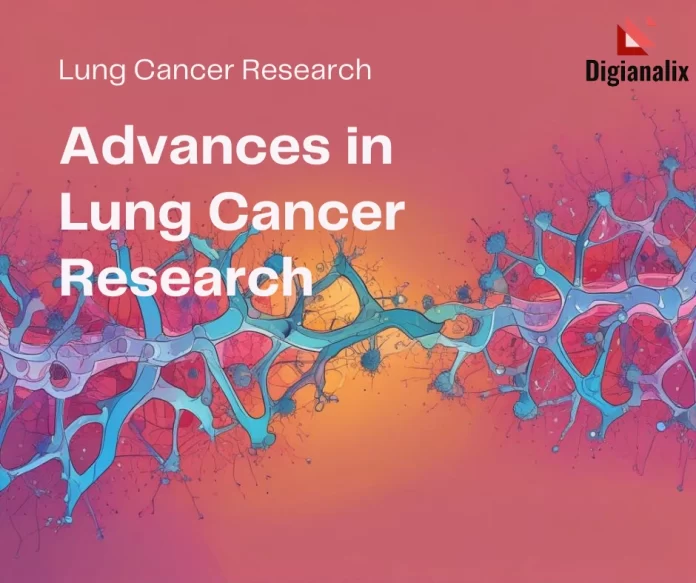Introduction
Lung cancer is one of the most common and serious cancers worldwide, ranking as the leading cause of cancer-related deaths. While smoking remains the primary risk factor, non-smokers can also develop lung cancer due to environmental exposures, genetic predisposition, and occupational hazards. Early detection is crucial, yet most cases are diagnosed at an advanced stage, making treatment more challenging.
Recent research has focused on improving early detection, understanding molecular mechanisms, and developing targeted and immunotherapies. This blog explores the causes, types, diagnosis, treatment options, and future advancements in lung cancer management.
Causes and Risk Factors of Lung Cancer
- Smoking: The leading cause, accounting for approximately 85% of cases. Tobacco contains over 7,000 chemicals, many of which are carcinogenic (e.g., benzene, arsenic, formaldehyde).
- Air Pollution: Long-term exposure to polluted air, including industrial emissions and vehicle exhaust, increases lung cancer risk.
- Occupational Exposure: Jobs involving asbestos, radon gas, silica dust, and other carcinogenic substances raise the likelihood of lung cancer.
- Genetic Factors: Family history and inherited gene mutations can contribute to lung cancer susceptibility.
- Diet and Lifestyle Factors: A diet lacking antioxidants from fruits and vegetables may impair lung cell repair, while alcohol consumption combined with smoking amplifies risks.
Types of Lung Cancer
Lung cancer is broadly classified into two main types:
- Non-Small Cell Lung Cancer (NSCLC):
- Accounts for about 85% of cases.
- Includes subtypes such as adenocarcinoma, squamous cell carcinoma, and large cell carcinoma.
- Can often be treated with surgery, chemotherapy, or targeted therapy in early stages.
- Small Cell Lung Cancer (SCLC):
- More aggressive and fast-spreading.
- Strongly associated with smoking.
- Typically treated with chemotherapy and radiation rather than surgery.
Symptoms of Lung Cancer
Lung cancer often remains asymptomatic until it reaches an advanced stage. Common symptoms include:
- Persistent cough
- Coughing up blood (hemoptysis)
- Shortness of breath (dyspnea)
- Chest pain
- Unexplained weight loss
- Fatigue
- Swelling in the face and neck
- Hoarseness
- Recurring lung infections like pneumonia or bronchitis
Diagnosis and Staging of Lung Cancer
1. Imaging Tests:
- X-ray and CT Scans: Identify abnormal growths in the lungs.
- PET Scans: Detect cancer spread to other organs.
2. Biopsy Procedures:
- Sputum Cytology: Examines coughed-up mucus for cancerous cells.
- Needle Biopsy: Extracts a small tissue sample from the lung using imaging guidance.
- Bronchoscopy: Uses a flexible tube to inspect the airways and collect tissue samples.
- Mediastinoscopy: Involves making an incision at the base of the neck to examine lymph nodes for cancer spread.
3. Staging:
Lung cancer is staged from Stage I (localized tumor) to Stage IV (spread to distant organs) to determine treatment plans. Small cell lung cancer is classified as limited stage (one lung) or extensive stage (spread to both lungs and beyond).
Treatment Options for Lung Cancer
1. Surgery:
- Used for early-stage NSCLC.
- Procedures include lobectomy (removal of a lung lobe) and pneumonectomy (entire lung removal).
2. Radiation Therapy:
- High-energy rays destroy cancer cells.
- Used as a primary treatment for patients ineligible for surgery or as an adjuvant therapy post-surgery.
- Stereotactic Body Radiation Therapy (SBRT): Targets tumors with precision, sparing healthy tissue.
3. Chemotherapy:
- Standard treatment for SCLC and advanced NSCLC.
- Used before surgery (neoadjuvant) to shrink tumors or after surgery (adjuvant) to eliminate remaining cancer cells.
4. Targeted Therapy:
- Attacks specific genetic mutations found in NSCLC, such as:
- EGFR inhibitors (Erlotinib, Afatinib): Effective for tumors with EGFR mutations.
- ALK inhibitors (Crizotinib, Alectinib): Target ALK gene rearrangements.
5. Immunotherapy:
- Enhances the immune system’s ability to fight cancer.
- Checkpoint Inhibitors (PD-1/PD-L1 Blockers): Drugs like Pembrolizumab (Keytruda) and Nivolumab (Opdivo) have shown success in NSCLC and SCLC.
- Often combined with chemotherapy for better results.
Advancements and Future Directions in Lung Cancer Research
- Liquid Biopsy:
- A non-invasive blood test detecting circulating tumor DNA (ctDNA) for early diagnosis and monitoring.
- Artificial Intelligence (AI) in Early Detection:
- AI-driven image analysis enhances lung nodule detection in CT scans, aiding in earlier diagnosis.
- Gene Therapy & CRISPR in Lung Cancer:
- Research is exploring ways to modify defective genes linked to lung cancer.
- Tumor Microenvironment Targeting:
- Strategies to disrupt cancer’s interaction with surrounding tissues to prevent tumor growth and spread.
- Personalized Cancer Vaccines:
- Tailored vaccines stimulating an individual’s immune system to recognize and attack lung cancer cells.
Prevention Strategies for Lung Cancer
- Avoid Smoking: Quitting smoking reduces lung cancer risk significantly.
- Minimize Air Pollution Exposure: Using air purifiers and avoiding high-pollution areas can help.
- Protect Against Occupational Hazards: Using protective gear in high-risk workplaces.
- Maintain a Healthy Diet: A diet rich in antioxidants, fruits, and vegetables may help reduce lung cancer risk.
- Regular Screening for High-Risk Individuals: Annual low-dose CT scans (LDCT) are recommended for current and former smokers.
Conclusion
Lung cancer remains a global health burden, but advances in molecular research, early detection methods, and innovative treatments are improving patient outcomes. While smoking cessation remains the most effective preventive measure, continued research on genetic therapies, immunotherapy, and AI-based diagnostics provides hope for more effective and personalized lung cancer treatments in the future.
By staying informed and proactive about lung health, individuals can take steps to reduce their risk and improve early detection outcomes.
-By – Neha Kumari, Shruti Sahu
References
- Babar L, Modi P, Anjum F. Lung Cancer Screening. StatPearls, 2020. [PubMed]
- Bray F, Ferlay J, et al. Global Cancer Statistics 2018. Cancer J Clin, 68(6):394-424. [DOI]
- van Meerbeeck JP, Fennell DA, De Ruysscher DK. Small-Cell Lung Cancer. Lancet, 378(9804):1741-1755. [DOI]
- Pikor LA, Ramnarine VR, et al. Genetic Alterations Defining NSCLC Subtypes. Lung Cancer, 82(2):179-189. [DOI]
- Ettinger DS, Wood DE, et al. Non-Small Cell Lung Cancer: NCCN Guidelines. J Natl Compr Canc Netw, 15(4):504-535. [DOI]
- American Cancer Society. Lung Cancer: Treatment and Prevention. [ACS]
📌 Stay updated on the latest lung cancer research at Digianalix!




